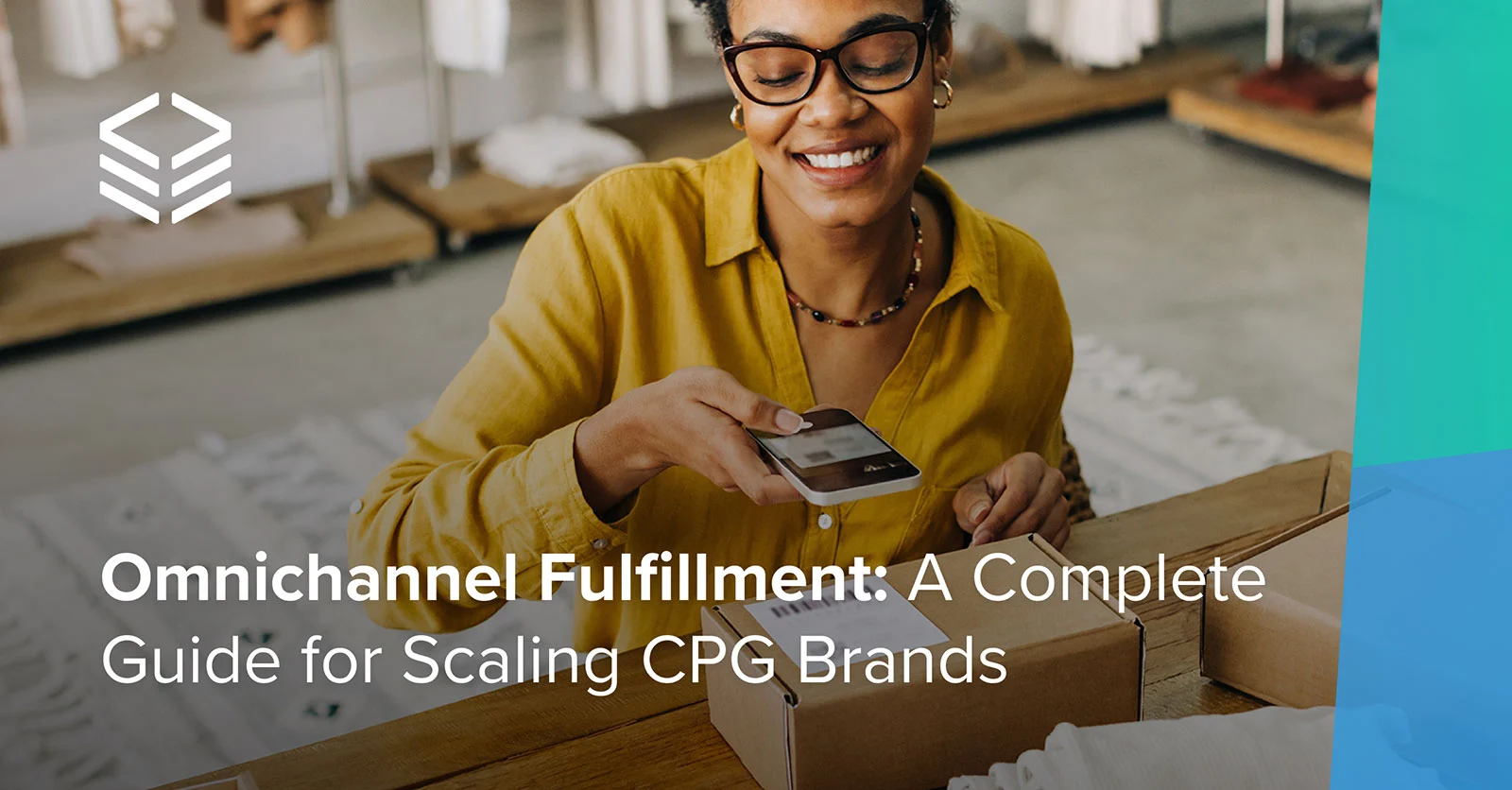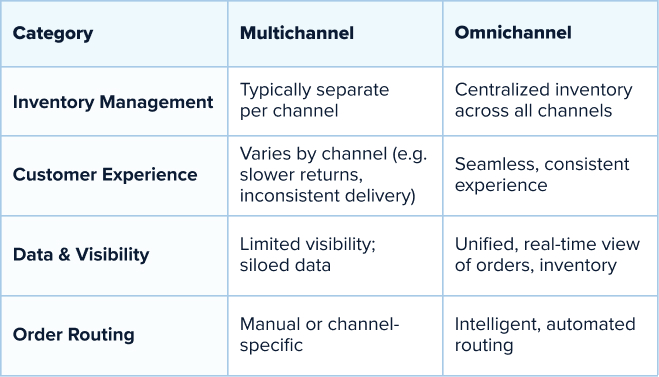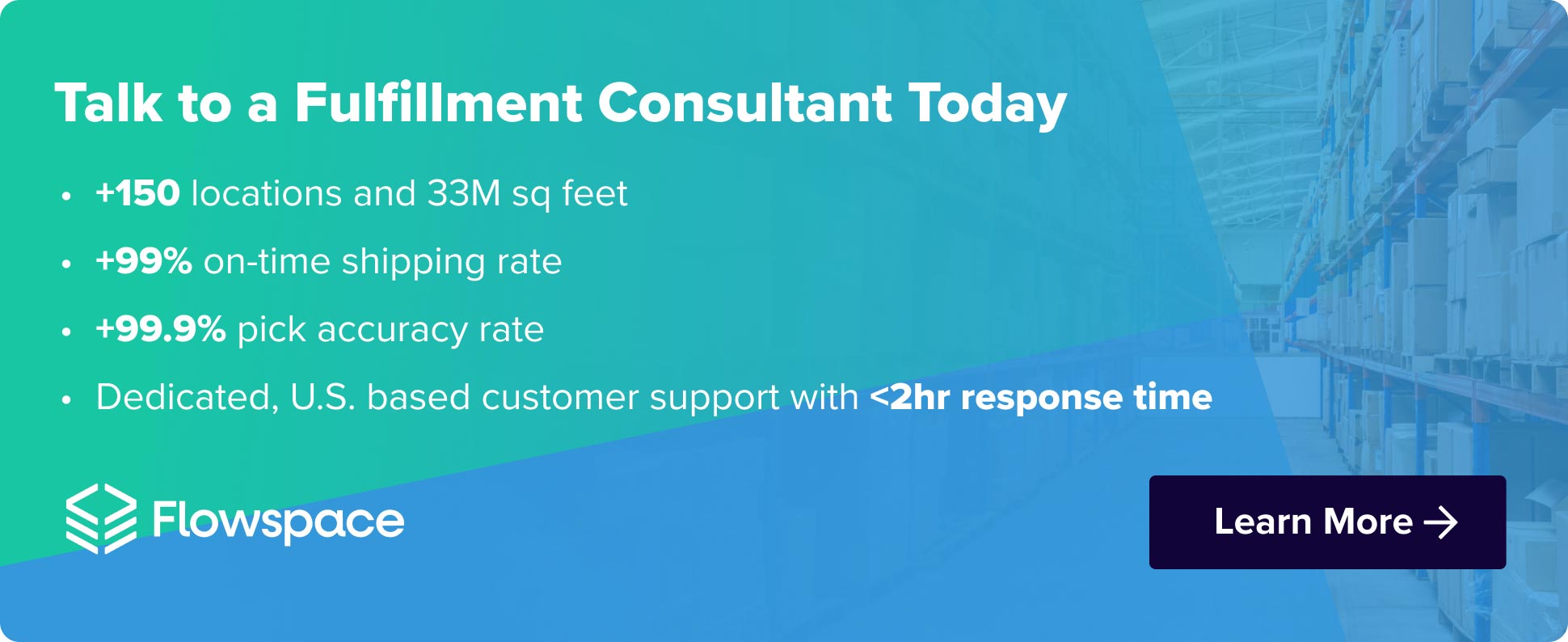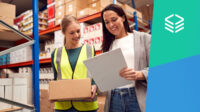
Whether your customers shop online, in-store, or both, they expect fast, frictionless experiences. For scaling CPG brands, guaranteeing these experiences can become an operational challenge.
That’s where omnichannel order fulfillment comes in. More than a buzzword, it’s a logistics strategy that connects your inventory, systems, and fulfillment workflows across every sales channel. The result is a single, agile operation that enhances speed, visibility, and customer satisfaction, regardless of the order’s origin or destination.
In this guide, we’ll unpack what omnichannel fulfillment means, benefits and challenges, future trends, and more.
What Is Omnichannel Fulfillment?
Omnichannel fulfillment connects your inventory, order processing, and delivery operations across every sales channel—whether that’s your ecommerce site, wholesale, retail stores, or marketplaces.
Instead of managing each channel separately, omnichannel fulfillment brings everything into a unified system that routes orders from the optimal location in real-time, reducing shipping costs, delivery times, and operational chaos.
This is an increasing necessity for scaling CPG brands. Today’s consumers expect consistent, flexible, and fast service no matter where they shop. Omnichannel fulfillment makes that possible by centralizing inventory visibility and enabling faster last-mile delivery.
Moreover, as U.S. ecommerce sales are projected to reach $1.8 trillion by 2029, the brands that scale efficiently will be those with fulfillment strategies that can flex and adapt. Omnichannel fulfillment gives you the infrastructure to grow without sacrificing speed, accuracy, or customer satisfaction.
Omnichannel vs. Multichannel Fulfillment
While the terms are often used interchangeably, omnichannel and multichannel fulfillment are not the same. Understanding the difference can help you choose the right strategy for your business and improve efficiency at scale.
Here’s how the two approaches compare:

Multichannel fulfillment pools together multiple channels, but potentially through fragmented systems, duplicated inventory, and inconsistent customer experiences. In short, there may be no true unification.
In contrast, omnichannel fulfillment centralizes your fulfillment operations, enabling real-time decision-making, faster shipping, and fewer stockouts. For scaling CPG brands, that means more efficient growth and stronger customer retention.
Challenges of Omnichannel Fulfillment
Omnichannel fulfillment offers major advantages—but executing it well requires the right infrastructure and foresight. Common challenges include:
- Complex setup: Integrating multiple sales channels, fulfillment nodes, and inventory systems takes planning and coordination.
- Real-time accuracy: Omnichannel success depends on up-to-date inventory and order data across all locations.
- Scalability pressure: As order volume grows, so does the complexity of routing, shipping, and returns.
- Tech and team alignment: Legacy systems or siloed teams can slow down even the best strategies.
To overcome these challenges, brands need more than software. They need a fulfillment partner that combines flexible logistics infrastructure with real-time operational visibility. Flowspace provides the tools, network, and expertise to help brands build and scale a successful omnichannel strategy from day one.
Four Basic Processes of Omnichannel Fulfillment
Omnichannel fulfillment enables brands to deliver a seamless shopping experience by integrating inventory, order management, and shipping across channels.
Here are the four core processes that power it:
1. Unified Order Management
Orders can originate from anywhere: a brand’s ecommerce site, a third-party marketplace, or a brick-and-mortar location. An omnichannel fulfillment system provider synchronizes inventory across all channels in real-time, preventing overselling, avoiding delays, and enabling merchants to fulfill orders as customers desire.
2. Smart Order Routing & Processing
Once an order is placed, routing logic determines the optimal fulfillment location. This helps reduce delivery times, lower shipping costs, and improve order accuracy. Customers receive confirmation with precise delivery estimates, regardless of where the item ships from.
3. Flexible Fulfillment Execution
Ecommerce fulfillment isn’t limited to a single source. With omnichannel, orders can be fulfilled from:
- Distribution centers or warehouses
- In-store inventory
- Micro-fulfillment centers
These nodes form a distributed inventory network—stock is strategically placed across locations to meet demand faster and closer to the customer. This flexibility reduces stockouts, maximizes inventory turnover, and keeps every node working efficiently.
4. Optimized Shipping & Delivery
Omnichannel fulfillment streamlines last-mile delivery by shipping from the most efficient location—whether that’s a warehouse, store, or partner facility. This reduces costs, speeds up delivery, and improves consistency across all channels.
Managing Omnichannel Returns & Exchanges
Streamlined returns management is essential to the customer experience, especially when purchases span multiple channels. But without unified systems, returns and exchanges can quickly become a source of confusion, delays, and lost revenue.
Omnichannel fulfillment helps brands streamline this complexity by centralizing inventory data and syncing return logic across sales and fulfillment channels. This reduces manual effort, shortens turnaround time, and gives customers the flexibility they expect, while helping brands recover inventory faster and maintain accuracy across the network.
Key KPIs & Benchmarks for Scaling CPG Brands
Tracking the right omnichannel fulfillment metrics helps CPG brands identify bottlenecks, reduce costs, and scale operations with confidence.
Here are some core logistics KPIs to monitor:
- Perfect order rate: Measures orders delivered on time, in full, with no errors.
- Order cycle time: Time from order placement to delivery. Lower times improve CX and retention.
- Inventory turnover ratio: Tracks how quickly inventory sells through. Higher rates signal lean, efficient ops.
- On-time delivery rate: Percent of orders delivered within the promised window.
- Return rate: Helps flag product issues or mismatched customer expectations across channels.
- Fulfillment cost per order: Total fulfillment spend divided by order volume. Useful for benchmarking efficiency.
- Stockout rate: Frequency of inventory unavailability. A key driver of lost revenue and loyalty.
Future Trends: Exception Management, Sustainability & Compliance
As CPG brands scale, the demands on fulfillment systems go beyond speed and cost. Meeting customer expectations now means building resilience, accountability, and adaptability into every part of your operation, which the following trends exemplify:
- Exception management: Brands are investing in proactive tools that detect and resolve inventory, routing, and delivery issues in real time, minimizing disruption and customer impact.
- Instant gratification: Same-day delivery is shifting from a premium service to an expectation. Data from GlobeNewswire revealed that the same-day market is set to grow 5 times by 2032 and is driven by the need for instant gratification from consumers, and enabled by logistics technology such as route optimization, real-time tracking, and automated warehousing.
- Unification: To meet omnichannel demands—from retail to ecommerce—brands are implementing centralized order systems and inventory optimization. Innovations like micro-fulfillment centers support ultra-fast delivery and services like BOPIS, aligning with rising consumer expectations.
- Adaptation is key: Fulfillment systems are being engineered for scalability, utilizing flexible warehousing solutions (e.g., shared vs. dedicated spaces) and dynamic labor management to quickly adapt to unpredictable peaks and troughs in order volumes, minimizing both over-investment and service disruptions.
Outsource Omnichannel Fulfillment to Flowspace
With the right infrastructure, software, and hands-on expertise, omnichannel fulfillment becomes the operational backbone for brands looking to scale while meeting customer expectations and controlling logistics costs.
Flowspace is the leading fulfillment operations platform built to power that transformation. Our end-to-end technology unifies inventory, streamlines order routing, and delivers real-time visibility across every channel. Backed by a flexible logistics network and expert support, Flowspace enables CPG brands to fulfill faster, operate more efficiently, and deliver the seamless experience customers expect.
FAQs
Still have questions? Here are quick answers to some of the most common questions we hear about omnichannel fulfillment.
How Does Omnichannel Fulfillment Improve Customer Experience for CPG Brands?
By unifying inventory and order data, every channel reflects real-time stock. Shoppers can buy, pick up, or return anywhere, cutting delivery times and stockouts while boosting loyalty metrics like repeat-purchase rate.
What’s the Key Difference Between Omnichannel and Multichannel Fulfillment?
Multichannel keeps inventory, data, and workflows siloed by sales channel. Omnichannel centralizes them under one system, letting orders route automatically to the fastest, lowest-cost node and enabling seamless cross-channel returns.
How Can I Optimize Omnichannel Fulfillment?
Start by centralizing your inventory, automating order routing, and ensuring real-time visibility across all channels. Flowspace makes this possible with a unified platform and nationwide network, so you can fulfill faster, reduce costs, and adapt to customer demand with ease.








